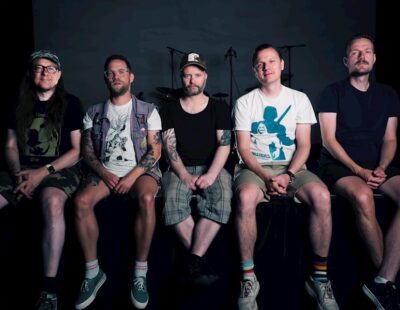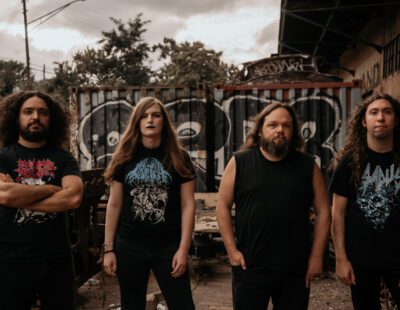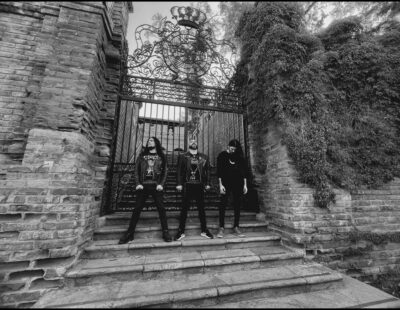** Dark Tranquillity have a new album out. It’s called Construct. As one of the many requirements of writing about metal is interviewing bands when they have new albums out. Hence, this feature. Actually, scratch that. I’ve been interviewing Dark Tranquillity for almost 20 years now, since the Skydancer effort, so me and the Gothenburg boys have a bit of a rapport. Not that I’m a creature of habit, but Construct is a fantastic album and Niklas, the interview subject below, has always been a reliable dude to talk to. Read on. Go buy Construct. And enjoy the brainjoy that results in listening to Construct.
I get this sense that Construct is a different record for self-preservation purposes. Any truth to that?
Niklas Sundin: Maybe. We never have a master plan during the songwriting, but on a personal level it was probably important for us to create something different in order to keep the fire burning, so to say. During the first 10 years of our career, we were seen as a pretty experimental and forward-thinking band, and I never was comfortable with being placed in some kind of stalwart “melodeath” (or whatever the kids call it these days) category where we were expected to deliver the same kind of music year after year, so from that perspective it feels good to have created something that strays a bit from the past couple of albums.
What was different about the creation of Construct compared to We Are the Void? Or, any of the previous albums, in fact.
Niklas Sundin: It was quite different in that we completely abandoned our usual modus operandi of writing and arranging the songs in the rehearsal room. We couldn’t get the creative juices flowing with all the six of us locked up in a tiny, smelling space with no windows and air flow, so instead we started experimenting with working directly in a studio setting instead. Not sure how much this actually influenced the outcome of the album, but it was a welcome change that gave us some new perspectives. It’s possible that we’ll return to the rehearsal room jamming sessions in the future, but for Construct another working method was needed.
It’s not like you’re strangers to stylistic shifts. Do think this is the biggest departure or would that honor still go to Projector?
Niklas Sundin: It’s too early to be able to be objective about the new album, but I’d say that Projector was a more radical change. It was the first album from our genre to feature clean vocals to that extent, and it had so many stylistic elements that were completely new, both to us and to our audience. While Construct is a different record, the metal climate in general is more open now than what it was 15 years ago, so the relative “weirdness” of the album is probably smaller than for Projector.
What was the songwriting split like this time around? I remember Henriksson was the main supplier in years past.
Niklas Sundin: Most of the music was written by Jivarp, Brändström and me, but every member is actively involved in the process and contributes to the arrangements. As usual with DT, there is a lot of collaboration, and many songs end up being very different from their first incarnations, so it’s hard to speak of songwriting in the traditional sense. Person A might have written all the original riffs for a song, but person B and C took them into a completely different direction. Well, you get the point. Henriksson’s main creative contribution this time was to compose and play the bass parts, a first for him since Projector. His bass style was always very creative, and I think it adds a lot to the final album.
I hear a lot more of Brändström on this record. He’s employed differently though. Lots of textures, main features, and score-like vignettes. How crucial was Brändström to Construct? I love his input on “Uniformity” and “None Becoming.”
Niklas Sundin: He wrote three songs solely by himself (“None Becoming” being one of them), and contributed heavily to most of the others, so I’d say that he was very crucial. The keyboards are certainly more audible this time around, and maybe a bit more organic, but Martin was always creating these multi-layered soundscapes. However, it’s notoriously hard to integrate that kind of keyboard arrangements into the already crammed audio space of a typical metal production, so in the past a lot of the different textures and nuances got lost in the final mix. Jens Bogren deserves all the credit for making the keyboards this present without making things less heavy. On the contrary, the electronics give a dark and uneasy feeling to the whole record, which is the perfect way to incorporate these elements in our music.
Then again, this is still very much Dark Tranquillity. “The Silence In Between” and “Weight Of The End,” for example, are tried and true Dark Tranquillity. Was it important to keep the DNA intact?
Niklas Sundin: I don’t know. Things just happened, and there was never any discussion of needing to safeguard by have some regular DT songs on there. In my view, “The Science of Noise” is the most typical song on the album—it easily could have been on Fiction or Character—but the ones you mentioned are also occupy a very traditional DT territory even if they both have parts that I’d consider a bit different for us. I think that the only DT element that isn’t very present on the album is the fast and semi-technical riffing with muted rhythms, but we had those in abundance on the past few records.
I like the compositional choices in “Uniformity.” That ending is quite cool. The slow lead out and Jivarp losing his drum mind. Really shows the band creatively on fire.
Niklas Sundin: Thanks! It’s a weird one for sure, but it’s already turning a lot of heads. It’s another one of those songs that took on a couple of very different guises before the final version manifested itself. The drum orgy at the end was a spur-of-the-moment thing, and the verse section and chorus originally sounded very different. For a long time we didn’t know quite what direction to steer the song in, or if it even would end up on the album at all, but it all came together in a good way in the end.
“Endtime Hearts” is kind of cool, too. Reminds me of a theme song to a Japanese cartoon. It’s all bouncy, sparse, and modern.
Niklas Sundin: [Laughs] Maybe you’re right! Haven’t thought of a cartoon vibe, but it’s certainly bouncy and with a strong beat throughout the whole song. As with a lot of the material on Construct, the chorus is actually an old riff that suddenly found its way into a song. I wrote it in 1999, and it was suggested for a few earlier albums in a more slow and doomy version, but no-one seemed to like it very much. This time, I was working on a more industrial and monotonous rhythmic riff (inspired by Einstürzende Neubauten’s “Was Ist Ist”, but one can’t really hear much resemblance now) and this old melody came to my mind and eventually became a catchy chorus instead of a slow droning thing. The guitar solo unintentionally owes a lot to the first Kent album, both in terms of the chords used but also with the e-bow harmonies in the backgrounds. All in all, it’s an eclectic mix of influences and a pretty different song for us. Should be a good live tune, though we haven’t really started thinking about that yet.
OK, I think “Immemorial” is atypical for Dark Tranquillity. Almost sounds Finnish. That folky melody, the sparkly guitar, and the accompanying keyboard line. Where’d this song come from sonically?
Niklas Sundin: On every recording, there’s usually one song with a lot of 3/4 time signature riffs, and they tend to be a bit folky. “Immemorial” started out by making an intro/verse/chorus block from some of Anders’ riffs and then trying some different alternatives out for a middle section. The folk melody was written in ’90s and seemed to fit perfectly. It’s pretty normal for us to mix old and new; every band member writes music, and we have library of thousands of riffs in all kinds of styles, so it’s often a case of waiting for the right moment or suddenly making a connection between a new and old idea that can bring a song to life. On We Are the Void, the whole of “Iridium” and parts of “Arkhangelsk” was written back in 1998, and on every album there are a usually a couple of really old riffs mixed with the recently written ones.
You recorded the album where? I know Bogren mixed it.
Niklas Sundin: We did all the recordings ourselves in Brändström’s studio, Rogue music. For the drums, parts of the neighbouring facilities—a classic prog studio called Nacksving—were utilized. It’s incredibly convenient, both since it’s located a short walk from where we live and also because it allows us to spend as much time as needed on the recordings. Studio work is always a stressful experience no matter what, but this setup is optimal for us.
And you said, “Haven’t been this excited about hearing our own music since 1993.” That’s a pretty big statement. What’s up?
Niklas Sundin: Yeah. That was something I put on Twitter for some stupid reason. I know that it sounds like typical promotional nonsense, but it’s rare for me to be this excited after a studio visit. We’re a very democratic band, so every song and riff gets tweaked and revised a lot of times, and in the past I often preferred earlier versions of songs than the ones that ended up on the albums. As a result, my usual reaction when hearing a freshly recorded album is that it turned out fine, but by virtue of our working method there are things that don’t fit my own personal taste to 100 percent. I’m sure that it’s the same thing for the other members. No one can be a fan of everything when there are five songwriters in the band. This time I can actually listen to a new DT album without being frustrated with how certain songs were “diminished”, which is a first for me since our debut album. However, this was never meant to be a huge PR statement, and it’s a case of 140 characters not being enough to give the full picture.
What inspires you guys at this point? I’m sure music is music, but tying in business, press, and touring is always a chore.
Niklas Sundin: It is—but there is no venture in the world that is fun and exciting 100 percent of the time. The only things that really matter are the creative process and the music itself. Until someone invents teleportation, touring will always be tough, and unless you’re a complete narcissist, doing interviews and press and having to deal with the public aspect of band life won’t always be a pleasant experience. But so far the positives outweigh the negatives, and we’re fortunate to have an audience for what we’re doing.
What was the reason for Daniel Antonsson’s departure? Are you bassist cursed? I’m joking, of course.
Niklas Sundin: The cursed DT. [Laughs] Nah, we’ve just had a handful of lineup changes in two decades, and Daniel was with us for a full four years, so it’s not that bad compared to a lot of other bands. There’s no radical reason behind his departure, and it sort of ties in with the previous question. You have to sacrifice a lot in order to be in a full-time band, and it’s hard to be on board without committing to 100 percent. Daniel was feeling creatively unfulfilled from not playing the guitar, and our touring schedule of 200+ shows per album doesn’t leave a whole lot of room for other ventures, so at the end of the day he figured that he’d be more happy founding his own band and also being able to devote more time to his studio work.
What do you hope Dark Tranquillity fans walk away with after listening to Construct?
Niklas Sundin: I haven’t thought of it, and it isn’t much of a concern. As cliché as it might sound, I never wanted to become a musician in order to serve people with music but rather to express something for myself. I’m sure that some old fans will view the album as a breath of fresh air and that some will think that we’ve “betrayed” whatever roots we supposedly have. And some will probably think that it sounds like a typical DT album. Either way is fine with me.
And plans for 2013? I’m sure touring.
Niklas Sundin: Yes! Summer festivals are being booked, and there are plans for both US and European headline tours in the fall. We can’t reveal any details just yet, but things look very promising on the planing front.
** Dark Tranquillity’s Construct is out now on Century Media Records. It’s available HERE, unless you’d rather chase down Fall of the Leafe’s Evanescent, Everfading effort on eBay. They’re on eBay, but they get really pricey really fast.





